Traditional Braces – Newington, CT
The Tried and True Way to Straighten Teeth
For generations, traditional braces have been one of the primary methods that orthodontists use to help patients achieve straighter teeth. Today, they remain high in popularity because they are so effective. Whether you are a child, teenager, or adult, this remarkable treatment may be able to play an instrumental role in helping you gain the healthy, attractive smile that you have always wanted. On this page, you will learn more about traditional braces and how they work.
How Do Traditional Braces Work?
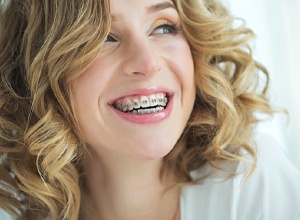
Traditional metal braces have two main components: brackets and wires. The brackets are small pieces that get bonded directly onto the teeth. They hold an arch wire in place. Together, the brackets and wires apply constant, gentle pressure to the teeth to gradually move them. When you visit us for periodic orthodontic appointments, we will adjust the braces so they continue to shift your teeth into their proper positions.
What Smile Problems Can Be Treated With Traditional Braces?
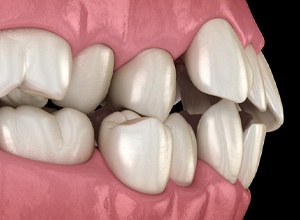
Traditional braces have the power to correct a wide range of dental misalignment issues. Whether the orthodontic problems plaguing your teeth are minor, moderate, or major, braces could be the key to getting the results you want.
Crowded Teeth
Teeth that are too close together, or that are overlapping, can lead to continual discomfort. They also present a challenge to dental hygiene. Braces, along with possible extractions, can move the teeth so they each have an adequate amount of space to thrive.
Spaces Between Teeth
Whether you have an annoying gap between your front teeth, or you have troublesome spaces further back in your mouth, braces may be able to shift teeth in a way that eliminates those empty areas.
Incorrect Bite Alignment
Overbite, underbite, and crossbite are all issues that can affect your jaw muscles and interfere with proper chewing. Braces can move the teeth in a way that creates a more harmonious bite.
Benefits of Traditional Braces
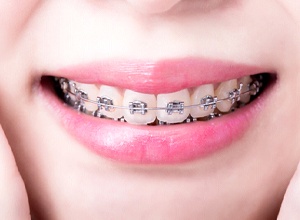
Traditional braces offer numerous advantages:
- They are reliable. Traditional braces have a remarkable track record of success.
- They are durable. As long as you follow recommended guidelines for caring for your braces, you are unlikely to encounter any problems with them.
- They let you express yourself. Many patients love to have colorful brackets, whereas others choose neutral hues for a more professional look.
- They are fixed in the mouth. The relative permanence of braces means you do not have to worry about forgetting to wear them.
- Modern braces are more comfortable than their predecessors. Although some soreness is normal as the teeth move, your overall experience with braces should be relatively comfortable. Drinking cool water and taking over the counter pain medication should be enough to mitigate any discomfort.
Understanding the Cost of Traditional Braces
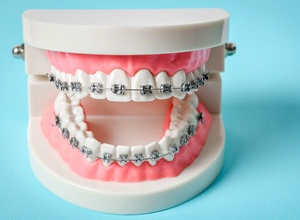
Traditional braces are one of the most affordable orthodontic treatments. At Family Dental of Newington, we even offer a special that can help almost any family fit braces into their budget. If you sign up for autopay, you can get braces for as little as $187/month — no money down is required. If you are interested in other payment options, we would be happy to discuss those with you as well.
Factors That Affect the Cost of Traditional Braces
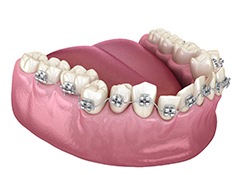
The total cost of traditional braces in Newington varies from patient to patient. It depends on a few factors, including:
- Severity of the dental misalignment. More severe orthodontic problems take longer to correct and may require special accessories. Therefore, the price is higher.
- Frequency of follow-up appointments. Patients typically need to visit us every 2 – 8 weeks for braces adjustments. The frequency of your appointments may impact your total financial obligation.
- Patient age. It tends to take longer to reposition an adult’s teeth than it does to reposition those of a child or teen. Therefore, more mature patients may end up paying slightly more than younger ones.
- Compliance with treatment. Mistakes in caring for your braces or teeth could extend your treatment and add to your total cost.
Professional Braces vs. “DIY” Braces: Which Costs More?

Have you seen stories on social media about people who have created their own braces? They might have used household items, like fishing line, earring backs, paper clips, and hair elastics to move their teeth. If you have been tempted to save money by trying out such a DIY hack, there are few things you should keep in mind:
- DIY braces are seldom successful. There is a strong possibility that you will harm your teeth or gums and will end up having to pay a significant amount of money to address the damage done. Some people have even caused irreparable damage to their smile.
- Your teeth may move incorrectly. DIY braces can move the teeth, but they usually do not do so in the right direction. You could end up worsening your dental misalignment.
It is almost always cheaper and wiser to opt for professional braces over DIY options.
Does Dental Insurance Cover Braces?

A handful of higher-end dental insurance policies cover braces. Some of them limit their coverage to minors, but others are willing to pay for orthodontic care for adults. If your policy applies to braces, it likely has a lifetime orthodontic maximum, which may reduce your out of pocket costs by hundreds of dollars (perhaps even a thousand dollars or more). Our insurance-friendly practice will do all we can to help you maximize your benefits.
Options for Making Braces Affordable

Outside of insurance, there are a few provisions that may make it easier for you to afford braces:
- You may qualify for third-party financing through CareCredit. The application process is fast, and most patients are approved for credit.
- Essential Dental Plan. This discount plan allows patients to enjoy reduced fees on most of the services that we offer.
Our team is ready to help you enjoy a straighter, healthier smile. Contact us to schedule your consultation. We will do all we can to help you successfully navigate the financial aspects of your care.
Traditional Braces FAQs
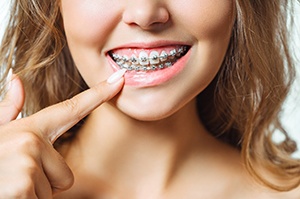
Would you like to straighten your teeth? Our team is ready to speak with you about your orthodontic treatment options, including traditional braces in Newington. In the meantime, though, you may have some questions. To help you find answers, we have put together a list of FAQs about this treatment. Make a note of anything you would like further explanation on — we are looking forward to speaking with you.
Am I Too Old to Get Braces?
Traditional braces are often associated with children and teens. However, there is no upper age limit for who can get them. In fact, roughly one-quarter of orthodontic patients are adults.
Your treatment may be somewhat different from that of younger people. For example, your teeth may move a bit more slowly, resulting in a slightly lengthened treatment timeline. However, your maturity and sense of responsibility can help you avoid unnecessary delays and facilitate a smooth orthodontic journey.
What Happens After You Get Your Braces Off?
Teeth have a sort of “memory,” meaning that once the pressure from your braces is gone, your smile will want to revert back to its former position. This can be prevented via the use of a retainer. A retainer is a small device that keeps the teeth in place. Immediately after you get your braces off, you will have to wear a retainer full time (20 – 22 hours each day). Later, though, you should be able to progress to wearing it only at night. Eventually, you may need to wear it only a few nights each week.
How Long Do Traditional Braces Take?
The average treatment time with braces is 18 – 36 months. However, your timeline may fall outside of that range; it depends primarily on the severity of your dental misalignment. Things like a patient’s age and their compliance with treatment guidelines can also impact how long their braces take. During your consultation, we will be able to estimate how long it will take for your braces to achieve optimum results.
Do Traditional Braces Hurt?
Many patients experience soreness in their teeth and gums during the first few days after their braces are placed. Soreness can recur anytime the braces are tightened. Sipping on cool water and taking over the counter pain relievers can help to alleviate discomfort. It would also be wise for you to eat mostly soft foods during this time period.
At other times, a stray wire or one of your brackets might irritate the soft tissues in your mouth. Usually, orthodontic wax can address this issue. However, if you experience any severe or persistent problems, you should call us for guidance.
What Can You Not Eat with Traditional Braces?
When you first get your braces, as well as after your braces get adjusted, you should adhere to a soft diet for a few days. This will minimize your discomfort. Foods like yogurt, soup, mashed potatoes, meatloaf, and scrambled eggs are good choices.
Throughout the entirety of your treatment, you should be careful to avoid any eating habits that could damage your braces. Here are some foods that it would be best to avoid:
- Popcorn
- Sticky and chewy candies
- Hard candy
- Nuts
- Crusty breads
- Chips and crackers
You should also be careful not to bite directly into certain foods. Rather, it would be best to cut them into small pieces first. Such foods include:
- Pizza crust
- Apples, celery, and other raw fruits and vegetables
- Meat on the bone
- Corn on the cob
Why Do My Teeth Feel Loose with Braces?
It is normal for your teeth to feel a little loose with braces; it can be a sign that your treatment is working! The loose feeling occurs because braces apply pressure to the teeth. This stretches the ligaments that bind the teeth to your jawbone. After you complete braces treatment, your teeth should go back to feeling very solid and strong in their places as your jawbone remodels and adjusts to your new smile.
If your teeth ever feel extremely loose, call us right away so we can evaluate the situation.
Can Traditional Braces Fix TMJ Disorder?
TMJ disorder (TMD) is a condition that affects the joints that control movement of the lower jaw. Often, dental misalignment can stress those joints, leading to facial pain, headaches, difficulty chewing, and many other symptoms.
If dental misalignment is contributing to your TMD, braces might be a long-term solution to the problem. As the teeth start to work better together, it can relieve stress on the jaw joints.
Of course, TMD can have many causes. Braces are not always the best treatment. Home remedies, special splints, and other conservative treatments may provide faster results in many cases.
Do Traditional Braces Cost More Than Invisalign?
The cost of orthodontic treatment varies significantly from case to case. On average, traditional braces cost a bit less than Invisalign. However, if your dental misalignment is severe, the cost might be more (because Invisalign is not designed to address complex cases). During your consultation, we can provide personalized cost information.
Regardless of which treatment you choose, you should be ready to spend at least a few thousand dollars to straighten your teeth. Fortunately, we offer a number of payment options that can make orthodontic care easier to afford. For example, we welcome insurance and offer low-interest financing options through third-party lenders.
